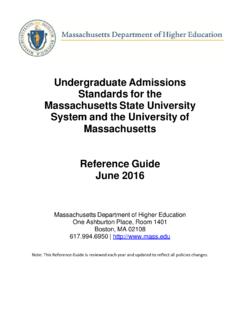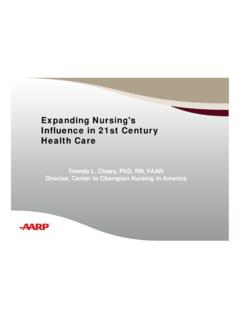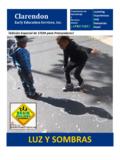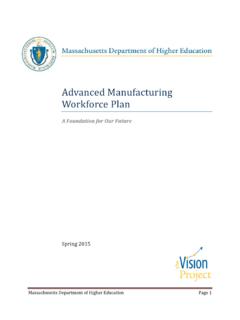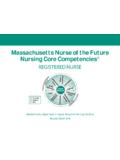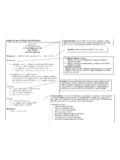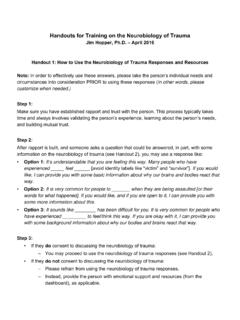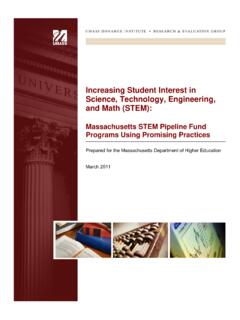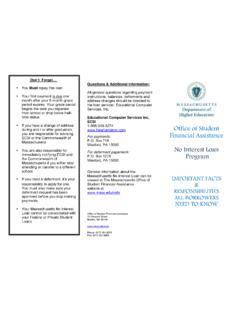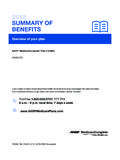Transcription of THE MASSACHUSETTS NURSING CORE …
1 THE MASSACHUSETTS NURSING core competencies :A Toolkit for Implementation in Education and Practice Settings The MA NURSING core competencies : A Toolkit for Implementation in Education and Practice Nurse of the Future Academic Practice The MA NURSING core competencies : A Toolkit for Implementation in Education and Practice Table of Contents Introduction .. 1 competencies and Case Studies .. 4 Gap Analysis .. 40 Evaluation Tools for NOF 41 Evaluation of Toolkit .. 42 References .. 43 Nurse of the Future Academic Practice 1 Introduction As articulated in the publication, Creativity and Connections Building the Framework for the Future of NURSING Education and Practice, published by the MASSACHUSETTS Department of Higher Education NURSING Initiative in August 2010: In March 2006, the MASSACHUSETTS Department of Higher Education (DHE) and the MASSACHUSETTS Organization of Nurse Executives (MONE) convened a facilitated work-ing session entitled Creativity and Connections: Building the Framework for the Future of NURSING Education and Practice.
2 This invitational session brought together 32 experienced professionals from the major statewide stakeholders in NURSING education and practice. The group included nurse leaders from a variety of practice settings, educators from both public and private higher education representing all degree levels, and representatives from the Department of Higher Education, the Board of Registration in NURSING , the MASSACHUSETTS Center for NURSING (MCN), the MASSACHUSETTS Association of Colleges of NURSING (MACN), the MASSACHUSETTS /Rhode Island League for NURSING (MARILN), and other national accrediting agencies, including the National League for NURSING Accrediting Commission (NLNAC) and the Commission on Collegiate NURSING Education (CCNE). An important outcome of the conference was the development of the following mission statement to guide future work: Establish a formal coalition to create a seamless progression through all levels of NURSING that is based on consensus competencies which include transitioning nurses into their practice settings.
3 An additional key outcome involved the establishment of the following top priorities: Creation of a seamless progression through all levels of NURSING education Development of sufficient consensus on competencies to serve as a framework for educational curriculum Development of a statewide nurse internship/preceptor program. Please refer to for a final conference summary. At the end of the conference a working group was formed composed of deans and faculty representing all segments of NURSING education, and NURSING practice leaders and clinical NURSING staff representing the continuum of care. From 2006 through 2009, the working group researched and reviewed standards, initiatives, and best practices in NURSING education and formed a foundation for moving the priorities forward. To expedite the process, the group formed two working committees: the MASSACHUSETTS Nurse of the Future (NOF) Competency Committee which was charged with furthering the development of a seamless continuum of NURSING education by identifying a core set of NURSING competencies ; and the MONE Academic Practice Integration Committee, which was charged with using the identified competencies as a framework for developing a statewide transition into practice model (DHE, 2010).
4 Work continued through 2011, when the MASSACHUSETTS Action Coalition (MAAC) was established and later was awarded the RWJF Academic Progression in NURSING (APIN) 2 First Edition, May 2014 grant in August 2012. In our project proposal, Academic Progression in NURSING : A Plan for the Commonwealth of MASSACHUSETTS , the goals are to: 1) Create accelerated pathways for nurses to achieve baccalaureate or higher degrees; 2) Promote the integration of the Nurse of the Future NURSING core competencies (NOFNCC); and, 3) Increase faculty pool available to educate nurses from BSN through doctoral degrees. The Nurse of the Future NURSING core competencies Joint Working Group has been working to develop a toolkit for academic and practice environments. Specifically we have: 1) Identified current use of NOFNCC in academic settings and current use of NOFNCC in practice settings; and, 2) Developed a toolkit and work with schools of NURSING and practice settings to integrate the NOFNCC into their curricula.
5 Strategies proposed in our APIN grant to accomplish this work included: Work with academic and practice institutions to integrate NOFNCC into curriculums at all levels of education and into practice programs. Specifically to: Develop curriculum blueprints, including toolkits, for use in academic and practice settings; Provide technical assistance to schools of NURSING and practice settings for implementation; Develop and implement student competency evaluation for end of year program outcomes and a competency evaluation tool for practice; Evaluate utilization and success of NOFNCC in academic and practice settings post roll out, including number of institutions adopting competencies . The purpose of this toolkit is to promote the integration of Nurse of the Future NURSING core Compenentencies (NOFNCC) in academic institutions and practice settings in the Commonwealth of MASSACHUSETTS .
6 This toolkit has been organized in a format that is useful to both. The integration of the competencies into academic programs connects the various levels of education programs, facilitating a smooth transition between LPN, ADN, and BSN programs, thereby increasing the likelihood that a nurse will continue his or her education. Furthermore, it is expected that the integration of these competencies may help differentiate the expected learning outcomes and achievement of competencies at the various educational levels. The integration of the competencies into practice facilitates a smooth transition for a new graduate into practice and allows academia and practice to better coordinate learning, precepting, and orienting activities. The NOFNCC document creates a common language that further facilitates integration in both academic and practice settings.
7 3 4 First Edition, May 2014 competencies and Case Studies Nurse of the Future NURSING core competencies Patient-Centered Care - Anne Marie Barron .. 5 Professionalism - Lynne Sullivan .. 7 Leadership - Judith Cullinane .. 8 Systems-Based Practice - Donna Glynn .. 10 Informatics and Technology - Daniel David .. 12 Communication - Donna Glynn .. 14 Teamwork and Collaboration - Joan Russo .. 16 Safety - Lynne Sullivan .. 18 Quality Improvement - Diane Hanley .. 20 Evidence-Based Practice - Judith Cullinane .. 22 5 Patient-Centered Care Anne-Marie Barron The Nurse of the Future will provide holistic care that recognizes an individual s preferences, values, and needs and respects the patient or designee as a full partner in providing compassionate, coordinated, age and culturally appropriate, safe, and effective care.
8 What is Patient-Centered Care and Why is It Important? Patient-centered care is at the core of all NURSING education and practice. The IOM (2003) identified patient-centered care as one of the five core competencies to be integrated into the NURSING curriculum. The AACN Essentials of Baccalaureate Education for Professional NURSING Practice (2008) describes patient-centered care as all NURSING actions that identify and integrate patient preferences, values, expressed needs and address the patient s pain and suffering. Further, AACN emphasizes that it is the nurse s professional responsibility to coordinate care, carefully listen to patient needs and concerns, clearly inform, communicate, and educate patients, advocate disease prevention and wellness, and emphasize both individual and population health. Questions for Reflection in Education and Practice: 1.
9 What are the elements of holistic NURSING care? 2. How do you assess for patient preferences and values? 3. What are the barriers and facilitators of patient-centered care? 4. How do you determine whether patient-centered care is being offered in your practice setting? 5. How are patient values and preferences incorporated in care offered in your practice setting? 6. How do you evaluate culturally appropriate care? Learning Activities in Education: 1. Incorporate reflective practice in clinical conference and in the classroom. 2. Develop case studies that invite students to utilize critical reflection as they consider the complex and holistic needs of patients, families, and populations. 3. Present case studies based on the expert practice of faculty as they care for patients. Learning Activities in Practice: 1.
10 Conduct unit-based NURSING Rounds that offer nurses the opportunity to critically reflect and collaborate with colleagues in relation to the holistic care they are offering. 2. Incorporate nurses narrative descriptions of patient encounters that demonstrate excellence in patient-centered care as part of the annual evaluation. 6 First Edition, May 2014 3. Incorporate nurses narratives of excellence in patient-centered care as an essential element of a clinical recognition or clinical ladder program. 4. Establish institutionally-based NURSING Grand Rounds that highlight excellence in patient-centered care as an essential element of practice. 5. Examine the website a. Compare this organization s HCAHPS scores to 2 other organizations. b. Discuss the unit s HCAHPS scores with the Nurse Leader. c. Describe any opportunities to improve the patient experience that are currently underway on this unit.
